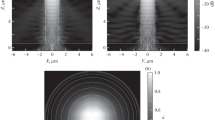Abstract
An efficient single-photon source is one of the key components in quantum secure communication systems. In this work, a clean quantum-dot single-photon source without side walls, consisting of a planar microcavity structure with an aperture in the light-blocking top metal layer, is designed to prevent spectral diffusion of single-photon emission. Such a source with an aperture diameter of 1000 nm provides a photon collection efficiency of 14%, increased from 0.5% for a quantum dot in GaAs, and one with an 800-nm aperture provides a Purcell enhancement of 1.7 with an excellent far-field radiation pattern. The dependences of the emission characteristics on the aperture size and the quantum dot misplacement are also investigated.
Similar content being viewed by others
References
K. Takemoto et al., Sci. Rep. 5, 14383 (2015).
M. Keller et al., Nature 43, 1075 (2004).
P. Senellart, G. Solomon and A. White, Nat. Nanotechnol. 12, 1026 (2017).
T. M. Babinec et al., Nat. Nanotechnol. 5, 195 (2010).
Y. M. He et al., Nat. Nanotechnol. 10, 497 (2015).
T. T. Tran et al., Nat. Nanotechnol. 11, 37 (2016).
K. G. Lee et al., Nat. Photonics 5, 166 (2011).
P. Michler et al., Science 290, 2282 (2000).
M. Gschrey et al., Nat. Commun. 6, 7662 (2015).
N. Somaschi et al., Nat. Photonics 10, 340 (2016).
O. Gazzano et al., Nat. Commun. 4, 1425 (2013).
J. Claudon et al., Nat. Photonics 4, 174 (2010).
V. Devaraj et al., Opt. Express 24, 8045 (2016).
A. Srivastava et al., Nat. Nanotechnol. 10, 491 (2015).
M. Pelton et al., Phys. Rev. Lett. 89, 233602 (2002).
E. D. Palik, Handbook of Optical Constants of Solids (Academic Press, San Diego, 1998).
S. Adachi, J. Appl. Phys. 58, R1 (1985).
Acknowledgments
This work was supported by the research fund of Chungnam National University.
Author information
Authors and Affiliations
Corresponding author
Rights and permissions
About this article
Cite this article
Jang, Y.D., Lee, D. Simulation Study of an Apertured Planar Microcavity for Efficient Single-Photon Sources. J. Korean Phys. Soc. 75, 63–67 (2019). https://doi.org/10.3938/jkps.75.63
Received:
Revised:
Accepted:
Published:
Issue Date:
DOI: https://doi.org/10.3938/jkps.75.63




